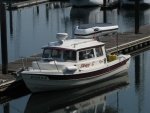Agree with Jody, I tried the 1 foot contour from Navonics last year, and it was super busy, with far more detail than you want for cruising. I have tried several of the various charts, including the Navionics, and Garmin. They all have errors. As Jody says, use the eyeballs. We do take short cuts, very slowly--and watch the depth on the sounder, and trim the motor up. Some short cuts can save many miles.
I also still use the various maps--the Stan Jones is a favorite of many, I carry the Kingfisher maps (North and South), and the Fish-N-Maps (North and South) I cut the laminated photo map by "Rainbow Gold", to the size of the dinette table, and then put an acrylic clear overlay--that way I can mark with a wax pencil if I wish.
There is a good discussion of maps on Wayne's World:
http://www.wayneswords.com/index.php?option=com_content&view=article&id=88&Itemid=57
And Wayne's World, in general: fishing information etc--great resource.
http://www.wayneswords.com
Another source is Fred's Liquor store. (Really more of A fishing store on S. Lake Powell Blvd right in town)--worth a visit and great place to get the fishing license. (and buy fishing lures).
http://fredsliquorstore.com/maps.html
Of course the most recent edition of the "Partner's West Boaters Guide to Lake Powell" is worth its weight in Gold. There are several hiking guides, I like to read at least one book on the history or stories of Lake Powell on each visit. Certainly the classic is John Wesley Powell History of His trips down the river, such as "The Great Unknown". Others are: "Ghosts of Glen Canyon, History beneath Lake Powell", Glen Canyon Dammed, The Colorado River Through Glen Canyon: Before Lake Powell,Lake Powell: Virgin Flow to Dynamo (out of print, but used book dealers have it on the cheap), we also carry the Audubon Field Guide to the SouthWest. One of the good bird books is also fun.
Things you can download to the I pad, or computer: Geology of the Canyon
http://www.utahgeology.org/road_logs/uga-29_first_edition/NR_guide/lakepowe.pdf
The Glen Canyon Natural History Association has a web page:
http://www.glencanyonnha.org/nature-geology/ They also have a brief Geology book: "Bare Essentials of Geology: Lake Powell and Glen Canyon.
Topo maps from one of the apps is very handy, such as Trailbehind, "Offline Topo maps". These are great for planning hikes, as well as looking at contours.
"Skipper" app (NOAA charts) covers this area with Topo maps which also should have the Active Captain coverage for this area. (Skipper is also a Trailbehind product, and switches to their Topo maps inland.
Lots to do and ways to expand the horizon with books, charts etc.

